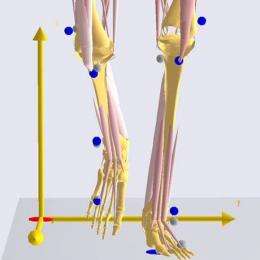Dutch researchers from the University of Twente's MIRA research institute, UMC St Radboud and various other institutions have developed a highly detailed computer model of the musculoskeletal system of the lower half of the human body. Surgeons can use this model to enhance their preparations for surgery, and even to "practice" these procedures in advance, using Virtual Reality. The model can be personalized for individual patients. The researchers recently received a European grant of 3 million euros for the development work.
Hip prosthesis revision surgery and operations to remove tumours can involve the loss of parts of bones or muscles. In such cases, muscles are sometimes repositioned to enhance the patient's functional abilities. When deciding exactly where to connect these muscles, surgeons usually rely on their intuition and experience. There are currently no suitable models capable of accurately predicting how the muscle will function following surgery or rehabilitation. In many cases, it is unclear whether the patient will still be able to walk normally after surgery.
Researchers from the University of Twente and various other institutions are currently developing a model that can accurately calculate the best place to connect the muscle and the best way in which to do so. MRI scans are used to personalize the model, creating a unique model for each specific patient. By using these personalized models in a Virtual Reality environment, surgeons are better able to plan surgical procedures in advance. The system can autonomously select the optimum site for muscle connection. It can also predict the consequences of specific choices. If so required, surgeons can even simulate entire operations in advance using a Virtual Reality environment.
The computer model is linked to an automated navigation system that is used during surgery. This ensures that the site selected by the system as the optimal location for muscle attachment can actually be used in the patient in question. The researchers compare this system to a satnav system. The system shows the surgeon exactly how certain muscles should be relocated in order to optimize the patient's musculoskeletal system.
According to the researchers, this system could benefit several hundred patients undergoing relatively major surgery in the Netherlands each year.
According to Prof. Nico Verdonschot and Prof. Bart Koopman, who are both members of the research team, the strength of the underlying musculoskeletal model lies in its accuracy, which is approximately five times greater than that of existing models. Uniquely, the system is based on a single, consistent dataset. This means that the body of a single individual is used as a basis (while existing models are composed of parts of different bodies). The fine detail of this individual's muscles, bones, tendons and attachments is mapped and digitized. As stated, the model is based on a consistent data set. However, an MRI scan is used to personalize the model for each patient, creating a model that is unique to the individual in question.
Provided by University of Twente


















